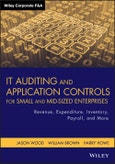If you're a financial auditor needing working knowledge of IT and application controls, Automated Auditing Financial Applications for Small and Mid-Sized Businesses provides you with the guidance you need. Conceptual overviews of key IT auditing issues are included, as well as concrete hands-on tips and techniques. Inside, you'll find background and guidance with appropriate reference to material published by ISACA, AICPA, organized to show the increasing complexity of systems, starting with general principles and progressing through greater levels of functionality.
- Provides straightforward IT guidance to financial auditors seeking to develop quality and efficacy of software controls
- Offers small- and middle-market business auditors relevant IT coverage
- Covers relevant applications, including MS Excel, Quickbooks, and report writers
- Written for financial auditors practicing in the small to midsized business space
The largest market segment in the United States in quantity and scope is the small and middle market business, which continues to be the source of economic growth and expansion. Uniquely focused on the IT needs of auditors serving the small to medium sized business, Automated Auditing Financial Applications for Small and Mid-Sized Businesses delivers the kind of IT coverage you need for your organization.
Table of Contents
Preface xi
Acknowledgments xiii
Chapter 1: Why Is IT Auditing Important to the Financial Auditor and the Financial Statement Audit? 1
Management’s Assertions and the IT Audit 2
Objectives of Data Processing for Small and Medium‐Sized Enterprises (SMEs) 5
Special Challenges Facing SMEs 8
Research Confirming the Risks Associated with SMEs 13
A Framework for Evaluating Risks and Controls, Compensatory Controls, and Reporting Deficiencies 16
Summary: The Road Ahead 20
Chapter 2: General Controls for the SME 21
General Controls: Scope and Outcomes 22
The “COSO Process” - Putting It All Together: Financial Statements, Assertions, Risks, Control Objectives, and Controls 30
Summary 35
Chapter 3: Application‐Level Security 37
Key Considerations 37
Initial Security Setup 40
Security Role Design 42
Password Configuration 44
Segregation of Duties 48
Personnel, Roles, and Tasks 49
Access Reviews 56
Human Error 58
Summary 58
Chapter 4: General Ledger and the IT Audit 59
The General Ledger: A Clearinghouse of Financial Information 60
Chart of Accounts for QuickBooks 62
SME Risks Specific to the General Ledger and the Chart of Accounts 65
Assertions Underlying the Financial Statements and General Ledger Controls 66
IT Controls, the Transaction Level, and the General Ledger 66
Summary 78
Chapter 5: The Revenue Cycle 81
Risk Exposures and Subprocesses 81
Application Controls, Revenue Cycle Risks, and Related Audit Procedures 84
Summary 105
Chapter 6: The Expenditure Cycle 107
Risk Exposures and Subprocesses 107
Application Controls, Expenditure Cycle Risks, and Related Audit Procedures 111
Summary 133
Chapter 7: The Inventory Cycle 135
Risk Exposures and Subprocesses 136
Application Controls, Inventory Cycle Risks, and Related Audit Procedures 143
Summary 157
Chapter 8: The Payroll Cycle 159
Risk Exposures and Subprocesses 159
Application Controls, Payroll Cycle Risks, and Related Audit Procedures 163
Summary 248
Chapter 9: Risk, Controls, Financial Reporting, and an Overlay of COSO on COBIT 249
PCAOB Warnings: Insufficient Evidence to Support Opinions 250
How We Got Here: A Historical Perspective 251
Risk 260
Risk and Fraud 261
Controls 262
Financial Reporting 269
PCAOB Guidance on IT Controls 279
Integrating COSO, COBIT, and the PCAOB 280
Summary 286
Chapter 10: Integrating the IT Audit into the Financial Audit 289
Risks, Maturity, and Assessments 290
Cross‐Referencing COBIT to the PCAOB and COSO 295
Plan and Organize 303
Program Development and Change 311
Computer Operations and Access to Programs and Data 317
Monitor and Evaluate 330
Summary 334
Chapter 11: Spreadsheet and Desktop Tool Risk Exposures 337
Specific Types of Risks and Exposures 338
Research on Errors in Spreadsheets 339
Compliance Dimensions of Spreadsheet Risk Exposures 344
Spreadsheet Auditing Tools 348
Governance of Spreadsheets and Desktop Tools 352
Control Considerations 355
Auditing Controls and Creating a Baseline 356
Life after the Baseline: Maintaining Spreadsheets and Desktop Tools 368
Summary 369
Chapter 12: Key Reports and Report Writers Risk Exposures 371
How Reports Are Used 371
Original Reports within the Application 372
Modified or Customized Reports within the Application 376
Reports Using Third‐Party Packages 378
Analyzing and Validating Reports 382
Summary 383
Chapter 13: IT Audit Deficiencies: Defining and Evaluating IT Audit Deficiencies 385
A Framework for Audit Deficiencies 385
Types of IT Audit Failures and Illustrative Cases 388
Use of Compensatory Controls 388
Ideas for Addressing Segregation‐of‐Duties Issues 388
Summary 398
References 399
About the Authors 405
Index 407








